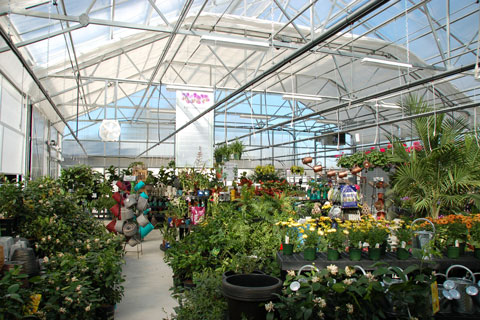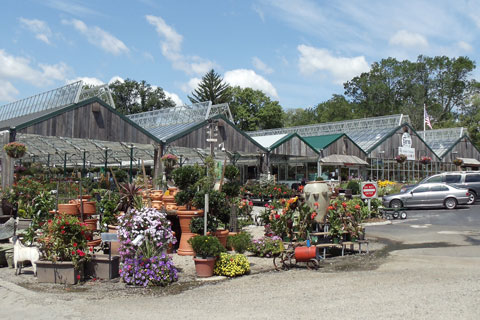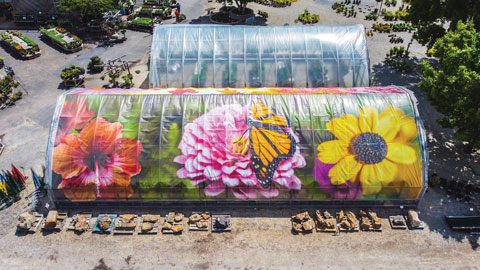7/1/2021
Staying On Trend
Jennifer Polanz
From adding covered outdoor shopping to widening aisles, going for taller greenhouse structures and trying something outside the comfort zone, here are a few ways retailers can offer consumers a safe and delightful shopping experience.
COVID-19 impacted retail sales over the past year and our industry was fortunate that we could be there for customers when they were looking for a safe outlet from the pandemic. Garden retailers made adjustments for safety, but based on what I heard from the sources I spoke with for this story, those adjustments just continue to be on trend with what’s been happening in the larger garden retail shift over the past decade.
“There’s no doubt outdoor covered shopping is a thing that will be here for a while,” says Chuck Sierke, National Sales Manager at Deforche Construct BV, a Belgian greenhouse manufacturer. “You can see from social distancing it was imperative that you provided more outdoor covered shopping areas.”
But those outdoor shopping areas were growing at a rapid rate anyway, he says, even before the pandemic. He cites the covered walkway in the shrub yard at Petitti Garden Center in Avon, Ohio, which allowed that location to better weather the Great Recession compared to other stores that didn’t have the covered shopping option.
“If they know you can come to this garden center even if it’s a rainy morning, and you can still go there and shop, it’s a home run,” Chuck says of customer appreciation. “Covered shopping is a low investment for the owner.”
More Airflow = Comfort
 With the pandemic receding, but not fully gone, one of the concepts that retailers of all types were striving for—better natural airflow—is baked into a lot of the offerings greenhouse manufacturers provide. Some prime examples of this are retail offerings from Stuppy that include wide bays, taller gutter heights, side venting and accommodating single or double roof motorized vents. They can be customized as needed, says Sales Manager Neil Devaney of the CS3 and Pro-Line options.
With the pandemic receding, but not fully gone, one of the concepts that retailers of all types were striving for—better natural airflow—is baked into a lot of the offerings greenhouse manufacturers provide. Some prime examples of this are retail offerings from Stuppy that include wide bays, taller gutter heights, side venting and accommodating single or double roof motorized vents. They can be customized as needed, says Sales Manager Neil Devaney of the CS3 and Pro-Line options.
“With the new garden centers being built over the last five years, natural ventilation is a trend,” Neil adds. “In larger spaces, there has been a push for that—really for the last 20 years—rather than fans and forced ventilation.”
Pictured: The greenhouse at Wingard’s Market in Lexington, South Carolina, is an example of the CS3 Aeromax model from Stuppy Inc.
Prospiant, which is a consolidated division of horticulture companies owned by Gibralter that includes Nexus and RBI product lines (along with other horticulture and agtech companies), also offers retail options that promote natural air flow, and they’ve been seeing trends toward that for quite a while. What’s also been trending for a while is growing your own and retailing in the same location, and the two, while keeping the natural airflow, don’t have to be mutually exclusive.
Prospiant’s Jeff Warschauer recently included a few highlights about which greenhouse structure attributes work best for growing and retailing comfortably in the Retail Greenhouse Design chapter of the new Ball RedBook 19th Edition. He notes
• Tall structures with high sidewalls tend to provide a cooler, more consistent climate.
• Wide structures are more cost effective when purchased in multiples and have fewer interior columns to interfere with growing space, customer aisles and merchandizing space.
• Glass, acrylic and polycarbonate glazing can provide a high level of light for growing and higher light levels during overcast days.
• Energy curtains can be used to control light and heat within the greenhouse environment, reflecting much of the solar gain and heat to keep customers comfortable. Curtains are also available to reduce light pollution if grow lights are being used at night.
 Pictured: The Farm at Green Village in Green Village, New Jersey, is an example of a recent retail greenhouse project from the Nexus product line at Prospiant.
Pictured: The Farm at Green Village in Green Village, New Jersey, is an example of a recent retail greenhouse project from the Nexus product line at Prospiant.
Continuing the Trend
Retailers are looking at continually updating and refreshing their spaces, and we would be remiss if we didn’t include long-time advice from an industry mainstay: late garden center consultant and architect Ernest Wertheim would advocate for wider concrete (or at least level) aisles at a minimum of a 12-ft. width.
“You could have a pallet of merchandise down the middle and customers shopping on either side and meet ADA code,” Chuck notes, recalling Ernest’s advice.
Chuck adds that retailers looking to add more space don’t necessarily have to make a full-on investment into a new greenhouse range. He points out the option of a lean-to, which he worked on with Pasquesi Home & Gardens in Lake Bluff, Illinois, a number of years ago. The lean-to is an affordable add-on that provides covered shopping space connected to the store.
Another option for spacing out customers in the garden center is to get mobile. “We have ways we can work with retailers to increase the spacing—we design benching systems, so that might be a stationary bench or a rolling bench,” says David Laverty, marketing manager at Prospiant. “We can design the best benching system for where they can place the plants.”
He notes, too, that more commercial greenhouses are heading toward an integrated solution with environmental controls, shading and cooling, and other attributes all controlled at one spot. He says this has been driven more from the controlled environment agriculture side, particularly cannabis, but it’s moving into horticulture and even retail, to help reduce labor costs and increase efficiencies.
And Now for Something Different
There’s nothing new about trying to catch a customer’s eye as they speed down the road, but Cameron Rees at Skinner Garden Store in Topeka, Kansas, took it to a new level. As a member of The Garden Center Group, he worked with Group Service Provider Tom Kegley of Tom Kegley Communications to create a giant, 68-ft. by 44-ft. full color mesh covering for his new shade hoophouse.
“The covering is a mesh vinyl,” Tom explains. “In this case, Cam needed light, so this lets 60% of light in. Another darker version lets 37% light in. [There’s] also a solid version for when light doesn’t matter.
“It is a functional substrate for our industry, but decorative!”
 Tom worked with Big Art Graphics in Virginia to print the vinyl mesh covering, and it’s actually reversible with a spring scene on one side and fall on the other.
Tom worked with Big Art Graphics in Virginia to print the vinyl mesh covering, and it’s actually reversible with a spring scene on one side and fall on the other.
According to Group Executive Director Danny Summers, “With visual impact for drive-by viewing, the installation makes a stunning and beautiful statement for the garden center.”
Pictured: Skinner Garden Store in Topeka, Kansas, went big with a vinyl mesh covering for a new shade hoophouse to bring in customers.
Planning Ahead
The advice from consultant and The Garden Center Group Service Provider Sid Raisch warranted its own separate segment. He sees a couple of different scenarios coming: 1) where grower-retailers are thinking of adding more space, either on the retail side to sell more or grower side to grow more (or both); 2) where retailers have deferred maintenance until they were able to afford it and are now trying to decide what to spend money on.
“Put the money first into a plan,” he advises. “The reason I say that is based on my experience of trying to help people fix designs that were not well done to begin with.”
It’s the age-old story of starting the operation as a fruit stand, farmers market or growing operation and expanding piecemeal throughout the years.
“It comes up a little at a time in a hodge-podge of a layout that really doesn’t function well, but has sacred cows all around it. Usually, they can be improved substantially with a good plan. You can take what you have and be much more functional with a good plan, rather than adding on another piece that makes it more dysfunctional.”
With that in mind, I’d also like to point out one more piece of the puzzle: the price of materials and availability lead times have increased this year, due to raw materials shortages, shipping and freight delays, and pandemic-related issues. Several of the sources I talked to noted that if a retailer is looking to expand, add on or do maintenance that involves replacements, they need to factor those delays and increases into their plans. GP